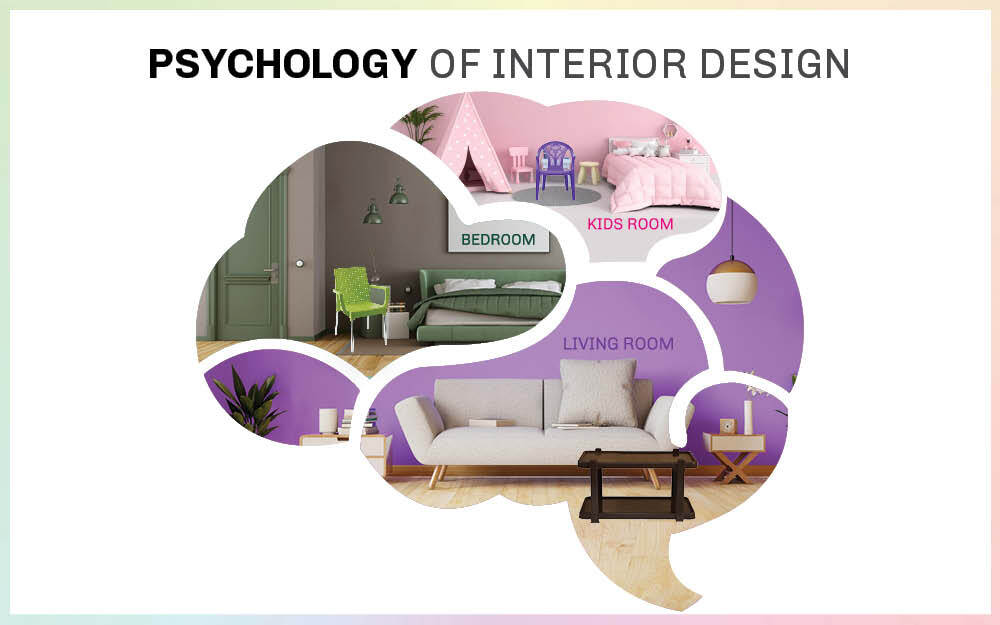
Psychology of Interior Design: how furniture affects your mood?
Share
Did you know that your home interiors can literally control your feelings?
There may be several subliminal triggers in your home design that cause changes in your moods and mental health.
When we think of decorating our house, our primary goal is to achieve a certain kind of aesthetic. We want our homes to look beautiful and pleasing to the eyes that can wow everyone. Some people also focus on utility.
But what most of us don’t realize is that there is a psychological aspect that connects us to the style and decor that we choose that gradually affects our mind as well.
In this blog, we will take you through all the different aspects of your home decor that may be affecting your mood and overall mental well-being.
Psychology of Colours
The colour of your interior may have a profound impact on your psyche. Psychology of colour is a vast area of study for interior designers. Different colours can have distinct effects on your mood. Hence, it is vital to understand the proper usage of colour in interior design before deciding upon a colour scheme for chairs, tables or decor items for your home.
- Red is an eye-catching colour and also raises the energy level of a room. However, it is a colour that can also induce anxiety and nervousness in many people.
- Yellow is a warmer shade that is known to evoke positivity and energy. While using a lot of yellow in your home might make your decor look loud and bright, a pop of yellow with neutral tones might be a good idea!
- Green is one of the most soothing colours for your home. It stimulates thoughts of peace, balance and immediately brings the idea of nature into our minds. Green shades are known to have a calming effect on one’s mind.
- Blue tones can bring a sense of peace to your mind. This colour is the most recommended colour for bedrooms as it is often associated with trust, serenity and success.
- Neutral colours such as black, nudes, browns, and whites make your interior colour palette flexible. You can pair these with other colours quite easily. Neutral colours are known to evoke feelings of balance, contentment and security.

Positioning of your furniture
The positioning of your furniture in your home determines your movement in that space. It is crucial to arrange furniture in a manner that is aesthetic as well as functional. If your house is very crowded, you might feel a sense of suffocation and anxiety more often than you realise. But at the other end of the scale, it is also not the best idea to line up your furniture against the walls and keep a large space in the middle. Set a focal point to arrange furniture, and a hero piece to set the room to organise it in a way that makes it comfortable to move around and enhances its utility without cluttering the space. If your home has ample space, it gives the illusion of abundance and makes the person feel satisfied and pleasant.
Ergonomics
Whether it is your home or your office space, the importance of ergonomic interior design is undeniable! Your workspace needs to be suited ergonomically to ensure maximum productivity. If you buy a fancy chair that goes perfectly with your decor but hurts your back within a few minutes of usage, it will make you irritated. Hence, it is advisable to use seating that offers excellent lumbar support. This aspect of comfort applies to other furniture as well. If you buy cabinets that do not have enough space to store your belongings, that may also cause anger and annoyance impacting your mood and behaviour in the long run. Hence, it is essential to focus on designs that are comfortable and functional for your workspace.
Natural Elements in Modern Interior Design
Being in proximity to nature can lift your mood and mental health in many ways. Having wooden interior settings not only elevates your style, but it also brings in the feelings of calmness. Indoor plants and greenery add to your mood. Like we mentioned earlier, green shades tend to have a calming effect on people and hence having a decor with Natural Earthy elements like indoor plants can make you feel fresh, rejuvenated and peaceful. The sight of plants also enhances your memory retention and inspires productivity.

Not only do plants look good in your home, but they also keep the air fresh. Floral prints, tropical prints or rustic prints are also known to boost your morale.
Health and Safety in Interior Design
If your home is not designed with safety as a priority, then it can build up a lot of irritation and anger. If your home is full of accident-prone sharp edges which keep causing minor injuries, such as the constant banging of your toe against your furniture, you may not be able to feel very safe in your own space. High Quality and Aesthetically pleasing Plastic furniture might be a great option to avoid such injuries and accidents.
The overall safety of your home may also affect your mental wellbeing. Hence, it is advisable to keep a proper locking system in your homes and install additional locking mechanisms on your windows and balconies so that you can live at peace without worry about the safety of you or your family.
Shapes and symmetry
Symmetry and shapes can also affect the overall vibe of your home. If you want your home to feel welcoming, you should steer clear of more angular shapes and use curves and circles instead. Curves and rounded shapes denote harmony and completion. Angular shapes represent efficiency, professionalism and balance. Symmetry also adds to the sense of balance and harmony. It is also aesthetically pleasing and enhances your mental peace.

Lighting in Interior Design
Whether it is natural or artificial, lighting is an essential aspect of home design. Extreme brightness can cause an overpowering feeling making you may feel suffocated and anxious. On the flip side, if the lighting is too feeble and dull, it can cause depression and anxiety. Your living room should be the most brightly illuminated, best if it’s natural light in the morning and strong artificial lights in the latter half of the day. The bedroom should have soft and cosy lighting to radiate comfort and relaxation.

It is imperative to design your home in a way that pleases both your mind and body. These are some of things that affect one’s psyche in terms of interior design that needs addressing during the planning stage itself. Your space should bring in comfort and make you feel like a safe haven!
If you love to know about home decorating tips or interior designing, then must visit our A-Z guide on decorating a home!
If you liked this blog, leave a comment down below and share it with your close ones. Let us know in the comment section if you have any other home designing tips that benefit mental health!






